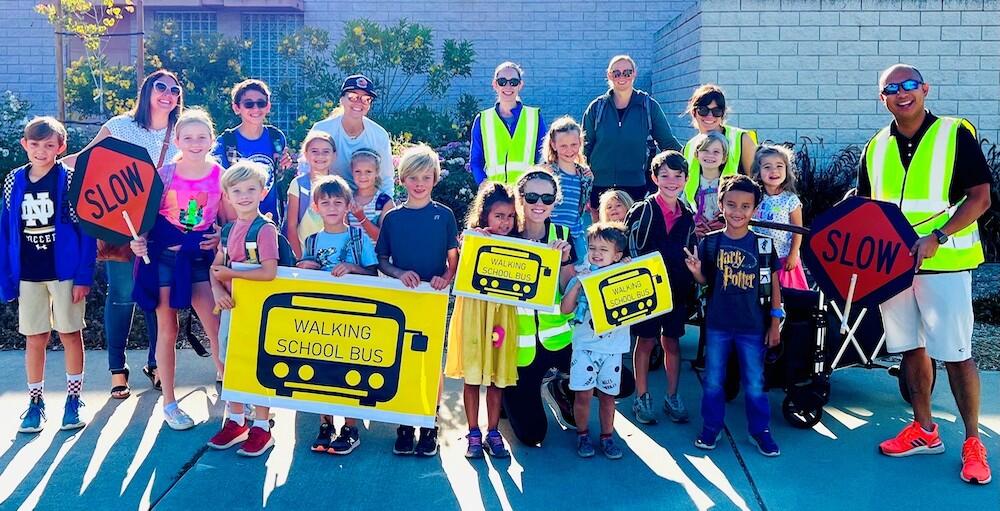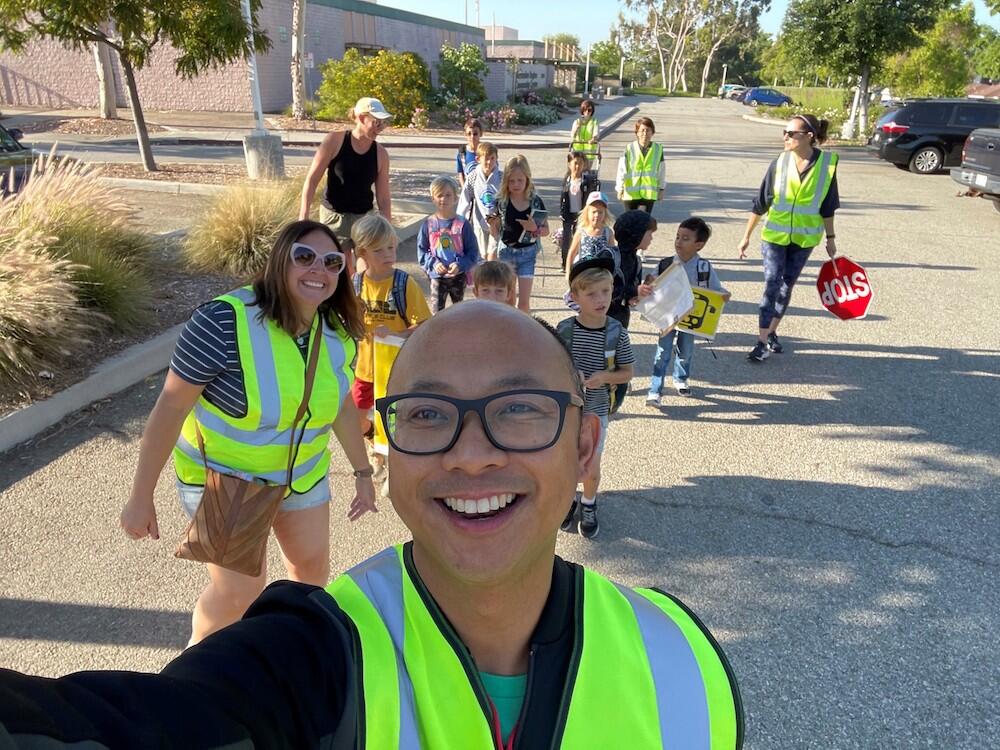For this installment of Stories from You, we're excited to feature a story from Maria Tipping, a City Engineer with the City of Claremont, California. In this story, Maria highlights how the City addressed community concerns to improve pedestrian and bicycle safety adjacent to school sites on Mountain Avenue through a new approach to evaluating complete streets options, piloting a Walking School Bus program in partnership with parents, school staff and almost 40 students at Condit Elementary School, and prioritizing funding for future safety improvement projects. She also shares about participating in the Complete Streets Safety Assessment (CSSA) program, a program funded by the California Office of Traffic Safety.
Since the onset of the COVID-19 pandemic, City of Claremont staff have noticed an increase with traffic safety and speeding concerns, reflected in the large number of residents contacting the city with requests for traffic calming and bicycle and pedestrian improvements as a means of slowing traffic down. As many experts agree, during the stay at home orders, while fewer people were on the road, those that remained on the road often engaged in riskier, unsafe driving behaviors. Though roads have become crowded again, excessive speeding and traffic safety continue to be a major source of concern for the community, especially on streets nearby or adjacent to local school sites. One of the local streets that draws much of the attention was Mountain Avenue, between Base Line Road and Bonita Avenue. This is a 1.7-mile minor arterial that provides access to two elementary schools and the only intermediate school in town.
Prioritizing Pedestrian and Bicycle Safety Around Schools in Claremont
Historically, traffic congestion and pedestrian and bicycle safety around schools have been one of the most common concerns shared by the residents. In response, the City has focused on prioritizing projects that address bicycle and pedestrian safety adjacent to school sites, by applying for competitive grants. This has been the necessary approach to fund these projects because the City does not have a dedicated funding mechanism to construct these types of projects. The City receives a limited amount of allocated local return funds such as Gas Tax including SB1, Measure R, and Measure M, which are prioritized for roadway maintenance, as part of the City budget adoption process. With limited resources, Claremont has been successful in obtaining numerous grants to fund projects to improve bicycle and pedestrian safety using the guiding principles of the City’s Complete Streets Policy as part of the roadway maintenance program. Over the years, the amount of grant funds received exceeds $20 million dollars, all invested in the community for bicycle and pedestrian safety improvements, adjacent to schools or along routes connecting to schools.
With school routes’ safety in mind, early this year, staff saw the opportunity to take a new approach to evaluating complete streets options for our local roads. With that purpose, staff applied for one of the available spots for the UC Berkeley Safe Transportation and Research Center (SafeTREC) Complete Streets Safety Assessment (CSSA) program to take the valuable opportunity to learn from the road safety experts through the CSSA process.
Staff learned that the CSSA process is a comprehensive transportation safety assessment that focuses on pedestrian and bicycle safety to help identify and implement traffic safety solutions that lead to improved safety for all roadway users. As part of the assessment, the traffic safety experts review the local agency's pedestrian and bicycle traffic safety programs, conduct a site visit, assess the safety conditions, and then suggest new strategies to improve safety for all modes of transportation in the community.
The CSSA and the Claremont Walking School Bus

Condit Elementary School Walking School Bus group photo in Claremont, CA (Photo: Mayor Jed Leano)
In February 2022, the City of Claremont was selected to be part of this year’s CSSA program. Claremont requested that a corridor assessment be conducted for Mountain Avenue for its function as a school route. The complete streets safety assessment was conducted in March, with great success. To start the process the UC Berkeley experts (John Ciccarelli and Afsaneh Yavari) met with City staff at the Condit Elementary School site. The assessment team was joined by school parents familiar with the student pick up and drop off challenges at this location, in an effort to get first-hand information on traffic congestion and traffic patterns around the school.
Claremont Mayor, Jed Leano, volunteered to join the group as a Condit Elementary School parent. The field assessment and parents’ feedback led to a very positive exchange of ideas, including the possible implementation of a Walking School Bus to help alleviate the traffic congestion and promote healthy options for children to get to school. During the assessment, John Ciccarelli and Afsaneh Yavari shared information on the Walking School Bus program and Mayor Leano saw a great opportunity to introduce the concept to the Claremont community by organizing a Walking School Bus at his son’s school. The pilot program was a huge success with the participation of almost 40 kids towards the end of the school year. Their picture made it to the front page of the local newspaper.

Mayor Jed Leano leads the Condit Elementary School Walking School Bus (Photo: Mayor Jed Leano)
The following provides testimony from Mayor Leano, on the implementation of the very first Claremont Walking School Bus:
“Last school year, a few of us Condit Elementary parents formed the walking school bus for our students, held on the last four Wednesday mornings of the Spring ‘22 semester. After speaking with a Berkeley traffic engineer and reading multiple studies on walking to school taught me that walking school groups are a wonderful way for students to walk to school with adult supervision. The largest issue that makes parents hesitate to allow their children to walk to school is potential danger, but our walking school bus ensures that all participating students are safely guided to school.
The biggest learning outcome from creating the walking school bus was learning how many parents drive their kids a very short, walkable distance to school. Among the many benefits, students and parent leaders improve their health by increasing their physical activity. Students spend more time outside with their friends, and parents improve their time management. Parents can reduce car traffic and unnecessary pollution. Families can reduce their carbon footprint in an easy, community-building way. Our walking school bus has become very popular, and I look forward to seeing it expand during the upcoming school year.”
Funding Future Safety Improvements
In light of the CSSA positive experience and valuable feedback received, the CSSA not only inspired the Condit Elementary School Walking School Bus, the City also decided to move forward with the budgeting of a Capital Improvement Project (CIP) for the Mountain Avenue corridor as part of the most recent budget preparation process. The recently adopted 2-year budget includes funding for the design and construction of the Mountain Avenue Corridor Complete Streets Project. This project will incorporate new complete streets features to the portion of the road in front of Condit Elementary and will add more complete street components to the portions of the roadway where a “road diet” was implemented years ago. Staff will use the CSSA assessment and suggestions, based on the UC Berkeley expert assessment and knowledge of best practices in traffic engineering and planning, to plan this new safety improvement project. Claremont is excited to share this success story, which has inspired so many positive outcomes for our community.
This Stories From You was coordinated in collaboration with UC Berkeley SafeTREC. The opinions and perspectives expressed are those of the author and not necessarily those of SafeTREC or the Office of Traffic Safety.
Funding is provided by a grant from the California Office of Traffic Safety (OTS) through the National Highway Traffic Safety Administration (NHTSA).

